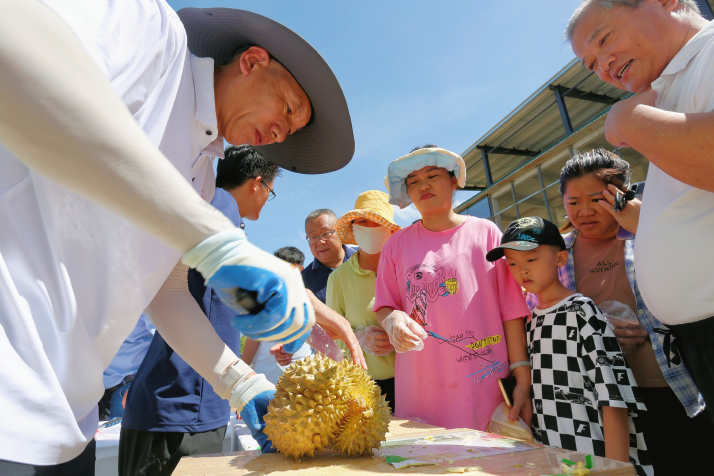
China has a large market for durians, which are characterized by their strong smell and popularly known as the “king of fruits,” but until this year, the country has relied on imports to satisfy domestic demand.
According to the Huaon Industrial Research Institute, China is the third largest durian market in the world following Indonesia and Malaysia, and accounts for 19 percent of the global total consumption. Data from the General Administration of Customs of China (GACC) show China imported 224,400 tons of fresh durians in 2017 and 821,500 tons in 2021. In the first quarter of this year, the volume and value of fresh durian imports were 91,400 tons and $507 million, a year-on-year increase of about 154 percent and 125 percent, respectively.
Zhao Bin, the product development director of online grocery platform Dingdong Maicai, told China Newsweek that durian is special because among all the fruits in China, there is no fruit that is close in taste to it. Therefore, the fruit is irreplaceable and has a large group of loyal consumers which is still expanding.
The booming market demand has pushed up the price of the fruit. According to GACC statistics, the price of imported durian rose from 11.8 yuan ($1.6) per kg in 2015 to 33.1 yuan ($4.6) per kg in 2021, an increase of 180 percent.
In March, a news piece announcing the first batch of domestically produced durians would mature this summer was widely circulated online. Durian lovers were exhilarated by the news as they anticipated a reduction in durian prices and the possibility for them to realize “durian freedom”—buying durian whenever you want without worrying about the price.

A picky fruit
In July, durian trees grown in Hainan Province began producing fruit after three years of cultivation. Du Baizhong, General Manager of Hainan Youqi Agricultural Co., told China Newsweek that it’s not easy to grow durians in Hainan.
Hainan was once considered an “unsuitable area for planting durians.” Feng Xuejie, Director of the Institute of Tropical Fruit Trees of Hainan Academy of Agricultural Sciences (HAAS), told China Newsweek that as early as 1958, Hainan had introduced and planted durian trees from Malaysia. However, the trees collectively produced just one fruit owing to a lack of growing techniques.
In 2015, Huasheng Ecological Agriculture Base in Sandao Township, Baoting Li and Miao Autonomous County planted 44 durian trees and, with guidance provided by agricultural scientists from HAAS, the trees blossomed and bore fruits four years later. The scientists had improved the plants’ growing environment by imitating their micro-environment such as soil, water and sunshine in Southeast Asia. The progress prompted large-scale durian cultivation.
In March 2020, Du began the large-scale planting of durian in Sanya. As of now, he has planted more than 900 hectares of durian trees, almost half of Hainan’s total. At present, there are 2,000 hectares of durian trees in Hainan, less than 1 percent of that in Thailand.
Du has invested 340 million yuan ($47.2 million) in planting durian trees over the past three years. This year, 90 hectares of durian trees planted by Du’s company bear fruit, with an estimated output of 50 tons.
Durian has extremely high requirements for its growing conditions and cultivation. It must grow in the mountains, likes warm winters and cool summers, and requires a humidity of 75 to 85 percent. Its yield is easily affected by unfavorable weather conditions such as rainstorms, drought and strong wind.
When Du first started growing durian, the survival rate was only 60 percent. Now the survival rate has improved to 98 percent through cooperation with the Institute of Tropical Fruit Trees.
Compared with durian producing areas in Malaysia and Thailand, Sanya has low rainfall and rain is unevenly distributed between different seasons. To make up for this shortcoming, Du has built a large reservoir, which supplies water through an automatic irrigation system.
The durian trees are equipped with sensors that transmit the real-time humidity and temperature of the soil so that workers can monitor the need for irrigation and fertilizer.
However, growing durian in Hainan still presents challenges. Zhou Zhaoxi, a deputy researcher with the Tropical Crops Genetic Resources Institute of the Chinese Academy of Tropical Agricultural Sciences, told The Beijing News the area near the equator is most ideal for growing durian but that, while tropical, Hainan is further north of the equator. Climatic conditions such as typhoons from July to October every year pose further challenges for local durian cultivation. Zhou said more research is needed to improve growing techniques.
Durian hopes dashed
Golden pillow durians from Thailand, known for their exquisite sweetness and soft texture, are usually picked when only 70 to 80 percent ripe before being transported to China, leading to a less flavorful product. Similarly, although durians imported from Malaysia are picked after they are ripe, the use of liquid nitrogen quick freezing technology in cold chain transportation damages their aroma and flavor. The biggest advantage of domestic durians over these imported counterparts is the shorter distance to market—they can be picked after turning ripe and transported fresh, avoiding these problems and maximizing the quality delivered to consumers. However, at present, homegrown durians are rarely seen on the market due to their low production volume.
Homegrown durians are currently completely unavailable in offline supermarkets and fruit shops, and although there are stores selling them on e-commerce platforms, the prices are even higher than those of imported durians, owing to their low output and high consumer enthusiasm.
Durians have a longer growth cycle than other fruits and need to be thinned out during the fruiting process so that the remaining fruits will receive more nutrients and grow better.
In the first three years, all young fruit should be removed. In the fourth year, a tree can keep only five fruits, while a tree more than 10 years old can sustain 85 fruits.
Feng said large scale cultivation of domestic durians began only three years ago and each tree can keep five to six fruits at the most. Also, as most durians were bought by tourists at the orchard, few of them made it to the market this year.
Industry insiders say a drop in durian prices in the short term mainly relies on a significant increase in production in countries of origin and imports from more countries.
Before 2022, China had two main sources of durian imports: Thailand and Malaysia, with Thai durians accounting for the majority. GACC data in 2022 showed that of the 825,000 tons of durian imported that year, 780,000 tons came from Thailand. Moreover, only Thailand was allowed to export fresh durians to China, while Malaysia was limited to exporting frozen durians in order to meet China’s quarantine requirements.
Since the Regional Comprehensive Economic Partnership (RCEP) came into effect in January last year, China’s sources of durian imports have increased in number.
Last July, China signed an agreement to import fresh durians from Viet Nam. This was followed by a similar deal with the Philippines early this year, making it China’s third source of fresh durians.
Sanya Bureau of Agriculture and Rural Affairs plans to build a durian industrial park of more than 3,000 hectares within three to five years, which will make Hainan the third largest durian supplier in the domestic market after Thailand and Viet Nam.
Feng estimates that by that time, the price of domestic durian will fall to 20-40 yuan ($2.8-5.6) per kg. –The Daily Mail-Beijing Review news exchange item





